A Highly Selective Economical Sensor for 4-Nitrophenol
Abstract
:1. Introduction
2. Materials and Methods
2.1. Materials
2.2. Optical Measurements
2.3. Sensitivity of NaFl to Nitroaromatics in Aqueous Solution
2.4. Sensitivity of NaFl to Nitroaromatics in MeCN Solution
2.5. Sensitivity of NaFl to Nitroaromatics on an Economical Filter Paper (as a Solid Phase Sensor)
2.6. Electrochemical Analysis
3. Results and Discussion
3.1. NaFl Sensor for Nitroaromatics in Aqueous Media
3.2. Testing of Nitroaromatics Using NaFl in MeCN
4. Conclusions
Supplementary Materials
Author Contributions
Funding
Data Availability Statement
Acknowledgments
Conflicts of Interest
References
- Snellinx, Z.; Nepovím, A.; Taghavi, S.; Vangronsveld, J.; Vanek, T.; van der Lelie, D. Biological remediation of explosives and related nitroaromatic compounds. Environ. Sci. Pollut. Res. 2002, 9, 48–61. [Google Scholar] [CrossRef] [PubMed]
- Roper, W. Toxicological Profile for Nitrophenols: 2-Nitrophenol 4-Nitrophenol (CAS#: 2-Nitrophenol 88-75-5; 4-Nitrophenol 100-02-7). Available online: https://wwwn.cdc.gov/TSP/ToxProfiles/ToxProfiles.aspx?id=880&tid=172 (accessed on 26 August 2021).
- Sun, X.; Wang, Y.; Lei, Y. Fluorescence based explosive detection: From mechanisms to sensory materials. Chem. Soc. Rev. 2015, 44, 8019–8061. [Google Scholar] [CrossRef] [PubMed] [Green Version]
- Diaz, Y.J.; Page, Z.A.; Knight, A.S.; Treat, N.J.; Hemmer, J.R.; Hawker, C.J.; Read de Alaniz, J. A Versatile and Highly Selective Colorimetric Sensor for the Detection of Amines. Chem.-A Eur. J. 2017, 23, 3562–3566. [Google Scholar] [CrossRef] [PubMed] [Green Version]
- Chen, D.; Peng, R.; Zhou, H.; Liu, H. Sensitive determination of 4-Nitrophenol based on its enhancement of a peroxyoxalate chemiluminescence system containing graphene oxide quantum dots and fluorescein. Microchim. Acta 2016, 183, 1699–1704. [Google Scholar] [CrossRef]
- Kumar, A.; Kumar, S.; Kumar, S.; Gupta, D.V. Adsorption of phenol and 4-Nitrophenol on granular activated carbon in basal salt medium: Equilibrium and kinetics. J. Hazard. Mater. 2007, 147, 155–166. [Google Scholar] [CrossRef]
- EPA Title 40: Protection of Environment. Available online: https://www.ecfr.gov/cgi-bin/text-idx?SID=fff5d53a14e2217cc5713bcd589a28c7&mc=true&tpl=/ecfrbrowse/Title40/40tab_02.tpl (accessed on 26 August 2021).
- Jáuregui, O.; Moyano, E.; Galceran, M.T. Liquid chromatography-atmospheric pressure ionization mass spectrometry for the determination of chloro- and nitrophenolic compounds in tap water and sea water. J. Chromatogr. A 1997, 787, 79–89. [Google Scholar] [CrossRef]
- Alber, M.; Böhm, H.B.; Brodesser, J.; Feltes, J.; Levsen, K.; Schöler, H.F. Determination of nitrophenols in rain and snow. Fresenius’ Zeitschrift für Anal. Chemie 1989, 334, 540–545. [Google Scholar] [CrossRef]
- Preiß, A.; Lewin, U.; Wennrich, L.; Findeisen, M.; Efer, J. Analysis of nitrophenols and other polar nitroaromatic compounds in ammunition wastewater by high-field proton nuclear magnetic resonance (1H-NMR) spectroscopy and chromatographic methods. Fresenius. J. Anal. Chem. 1997, 357, 676–683. [Google Scholar] [CrossRef]
- Verbitskiy, E.V.; Baranova, A.A.; Yakovleva, Y.A.; Chuvashov, R.D.; Khokhlov, K.O.; Dinastiya, E.M.; Rusinov, G.L.; Chupakhin, O.N.; Charushin, V.N. New “turn-off” fluorescence sensors to detect vapors of nitro-explosives on the basis of 4,6-bis[5-(heteroaryl)thiophen-2-yl] substituted 5-(4-tert-butylphenyl)pyrimidines. Arkivoc 2017, 2017, 341–355. [Google Scholar] [CrossRef] [Green Version]
- Maity, A.; Maiti, A.; Satpati, B.; Patsha, A.; Dhara, S.; Chini, T.K. Probing Localized Surface Plasmons of Trisoctahedral Gold Nanocrystals for Surface Enhanced Raman Scattering. J. Phys. Chem. C 2016, 120, 27003–27012. [Google Scholar] [CrossRef] [Green Version]
- Germain, M.E.; Knapp, M.J. Optical explosives detection: From color changes to fluorescence turn-on. Chem. Soc. Rev. 2009, 38, 2543–2555. [Google Scholar] [CrossRef] [PubMed]
- Liu, M.; Gao, Z.; Yu, Y.; Su, R.; Huang, R.; Qi, W.; He, Z. Molecularly Imprinted Core-Shell CdSe@SiO2/CDs as a Ratiometric Fluorescent Probe for 4-Nitrophenol Sensing. Nanoscale Res. Lett. 2018, 13, 1–9. [Google Scholar] [CrossRef] [PubMed] [Green Version]
- Geng, S.; Lin, S.M.; Liu, S.G.; Li, N.B.; Luo, H.Q. A new fluorescent sensor for detecting p-nitrophenol based on ß-cyclodextrin-capped ZnO quantum dots. RSC Adv. 2016, 6, 86061–86067. [Google Scholar] [CrossRef]
- Klonis, N.; Clayton, A.H.; Voss, E.W.; Sawyer, W.H. Spectral properties of fluorescein in solvent-water mixtures: Applications as a probe of hydrogen bonding environments in biological systems. Photochem. Photobiol. 1998, 67, 500–510. [Google Scholar] [PubMed]
- Zhang, X.-F.; Zhang, J.; Liu, L. Fluorescence Properties of Twenty Fluorescein Derivatives: Lifetime, Quantum Yield, Absorption and Emission Spectra. J. Fluoresc. 2014, 24, 819–826. [Google Scholar] [CrossRef] [PubMed]
- Klonis, N.; Sawyer, W.H. Effect of solvent-water mixtures on the prototropic equilibria of fluorescein and on the spectral properties of the monoanion. Photochem. Photobiol. 2000, 72, 179–185. [Google Scholar] [CrossRef]
- Nikalje, A. Nanotechnology and its Applications in Medicine. Med. Chem. 2015, 94, 206–215. [Google Scholar] [CrossRef]
- Schebesch, K.; Brawanski, A.; Hohenberger, C.; Hohne, J. Fluorescein sodium-guided surgery of malignant brain tumors: History, current concepts, and future projects. Turk. Neurosurg. 2016, 26, 185–194. [Google Scholar] [CrossRef]
- Togashi, D.M.; Szczupak, B.; Ryder, A.G.; Calvet, A.; O’Loughlin, M. Investigating Tryptophan Quenching of Fluorescein Fluorescence under Protolytic Equilibrium. J. Phys. Chem. A 2009, 113, 2757–2767. [Google Scholar] [CrossRef] [PubMed] [Green Version]
- Zhao, G.-J.; Han, K.-L. Hydrogen Bonding in the Electronic Excited State. Acc. Chem. Res. 2012, 45, 404–413. [Google Scholar] [CrossRef]
- Martin, M.M.; Lindqvist, L. The pH dependence of fluorescein fluorescence. J. Lumin. 1975, 10, 381–390. [Google Scholar] [CrossRef]
- Klonis, N.; Sawyer, W.H. Spectral properties of the prototropic forms of fluorescein in aqueous solution. J. Fluoresc. 1996, 6, 147–157. [Google Scholar] [CrossRef]
- Shi, W.; He, S.; Wei, M.; Evans, D.G.; Duan, X. Optical pH Sensor with Rapid Response Based on a Fluorescein-Intercalated Layered Double Hydroxide. Adv. Funct. Mater. 2010, 20, 3856–3863. [Google Scholar] [CrossRef]
- Chen, Y.; Zhu, C.; Cen, J.; Bai, Y.; He, W.; Guo, Z. Ratiometric detection of pH fluctuation in mitochondria with a new fluorescein/cyanine hybrid sensor. Chem. Sci. 2015, 6, 3187–3194. [Google Scholar] [CrossRef] [Green Version]
- Wu, Y.; Peng, X.; Fan, J.; Gao, S.; Tian, M.; Zhao, J.; Sun, S. Fluorescence Sensing of Anions Based on Inhibition of Excited-State Intramolecular Proton Transfer. J. Org. Chem. 2007, 72, 62–70. [Google Scholar] [CrossRef]
- Bräuer, M.; Mosquera, M.; Luis Pérez-Lustres, J.; Rodríguez-Prieto, F. Ground-State Tautomerism and Excited-State Proton-Transfer Processes in 4,5-Dimethyl-2-(2’-hydroxyphenyl)imidazole in Solution: Fluorescence Spectroscopy and Quantum Mechanical Calculations. J. Phys. Chem. A 1998, 102, 10736–10745. [Google Scholar] [CrossRef]
- Barman, N.; Singha, D.; Sahu, K. Fluorescence Quenching of Hydrogen-Bonded Coumarin 102-Phenol Complex: Effect of Excited-State Hydrogen Bonding Strength. J. Phys. Chem. A 2013, 117, 3945–3953. [Google Scholar] [CrossRef] [PubMed]
- Alty, I.G.; Cheek, D.W.; Chen, T.; Smith, D.B.; Walhout, E.Q.; Abelt, C.J. Intramolecular Hydrogen-Bonding Effects on the Fluorescence of PRODAN Derivatives. J. Phys. Chem. A 2016, 120, 3518–3523. [Google Scholar] [CrossRef]
- Kamlet, M.J.; Taft, R.W. The Solvatochromic Comparison Method. I. The β-Scale Of Solvent Hydrogen-Bond Acceptor (HBA) Basicities. J. Am. Chem. Soc. 1976, 98, 377–383. [Google Scholar] [CrossRef]
- Taft, R.W.; Kamlet, M.J. The Solvatochromic Comparison Method. 2. The α-Scale of Solvent Hydrogen-Bond Donor (HBD) Acidities. J. Am. Chem. Soc. 1976, 98, 2886–2894. [Google Scholar] [CrossRef]
- Reichardt, C. Solvatochromic Dyes as Solvent Polarity Indicators. Chem. Rev. 1994, 94, 2319–2358. [Google Scholar] [CrossRef]
- Nicoleti, C.R.; Marini, V.G.; Zimmermann, L.M.; Machado, V.G. Anionic chromogenic chemosensors highly selective for fluoride or cyanide based on 4-(4-Nitrobenzylideneamine)phenol. J. Braz. Chem. Soc. 2012, 23, 1488–1500. [Google Scholar] [CrossRef]
- Liptak, M.D.; Gross, K.C.; Seybold, P.G.; Feldgus, S.; Shields, G.C. Absolute pKa determinations for substituted phenols. J. Am. Chem. Soc. 2002, 124, 6421–6427. [Google Scholar] [CrossRef]
- Richards, J.H.; Walker, S. Dipole moment and infra-red studies of solvent effects on intramolecular hydrogen bonding. Part 4.—Nitroanilines and nitronaphthylamines. Trans. Faraday Soc. 1961, 57, 418–424. [Google Scholar] [CrossRef]
- Laws, W.R.; Contino, P.B. [21] Fluorescence quenching studies: Analysis of nonlinear Stern-Volmer data. Methods Enzymol. 1992, 210, 448–463. [Google Scholar] [CrossRef] [PubMed]
- Mei, Q.; Shi, Y.; Hua, Q.; Tong, B. Phosphorescent chemosensor for Hg2+ based on an iridium(iii) complex coordinated with 4-phenylquinazoline and carbazole dithiocarbamate. RSC Adv. 2015, 5, 74924–74931. [Google Scholar] [CrossRef]
- Daglar, B.; Demirel, G.B.; Bayindir, M. Fluorescent Paper Strips for Highly Sensitive and Selective Detection of Nitroaromatic Analytes in Water Samples. ChemistrySelect 2017, 2, 7735–7740. [Google Scholar] [CrossRef]
- Yin, H.; Zhou, Y.; Ai, S.; Liu, X.; Zhu, L.; Lu, L. Electrochemical oxidative determination of 4-Nitrophenol based on a glassy carbon electrode modified with a hydroxyapatite nanopowder. Microchim. Acta 2010, 169, 87–92. [Google Scholar] [CrossRef]
- Zhang, Y.; Wu, L.; Lei, W.; Xia, X.; Xia, M.; Hao, Q. Electrochemical determination of 4-Nitrophenol at polycarbazole/N-doped graphene modified glassy carbon electrode. Electrochim. Acta 2014, 146, 568–576. [Google Scholar] [CrossRef]

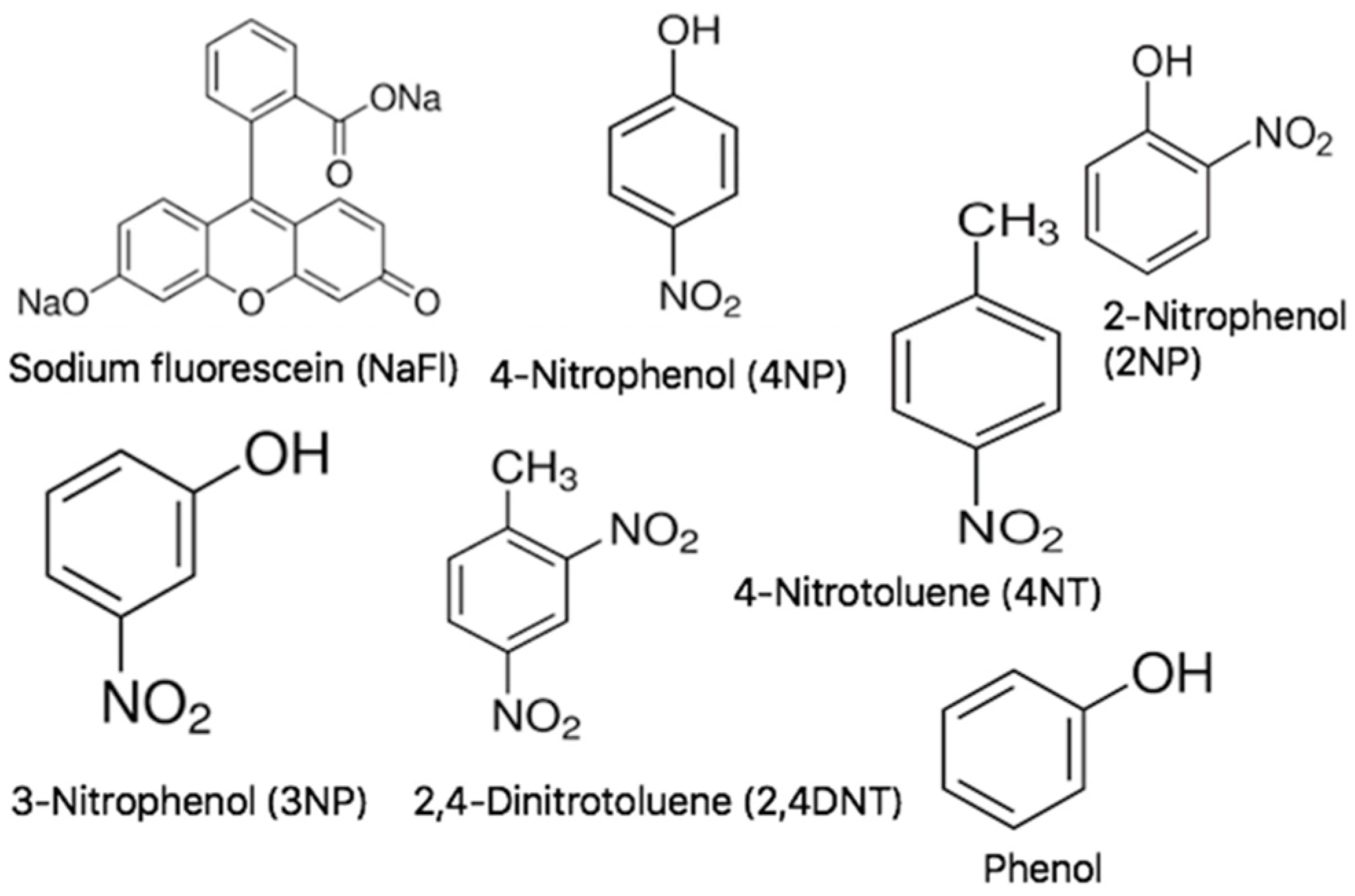
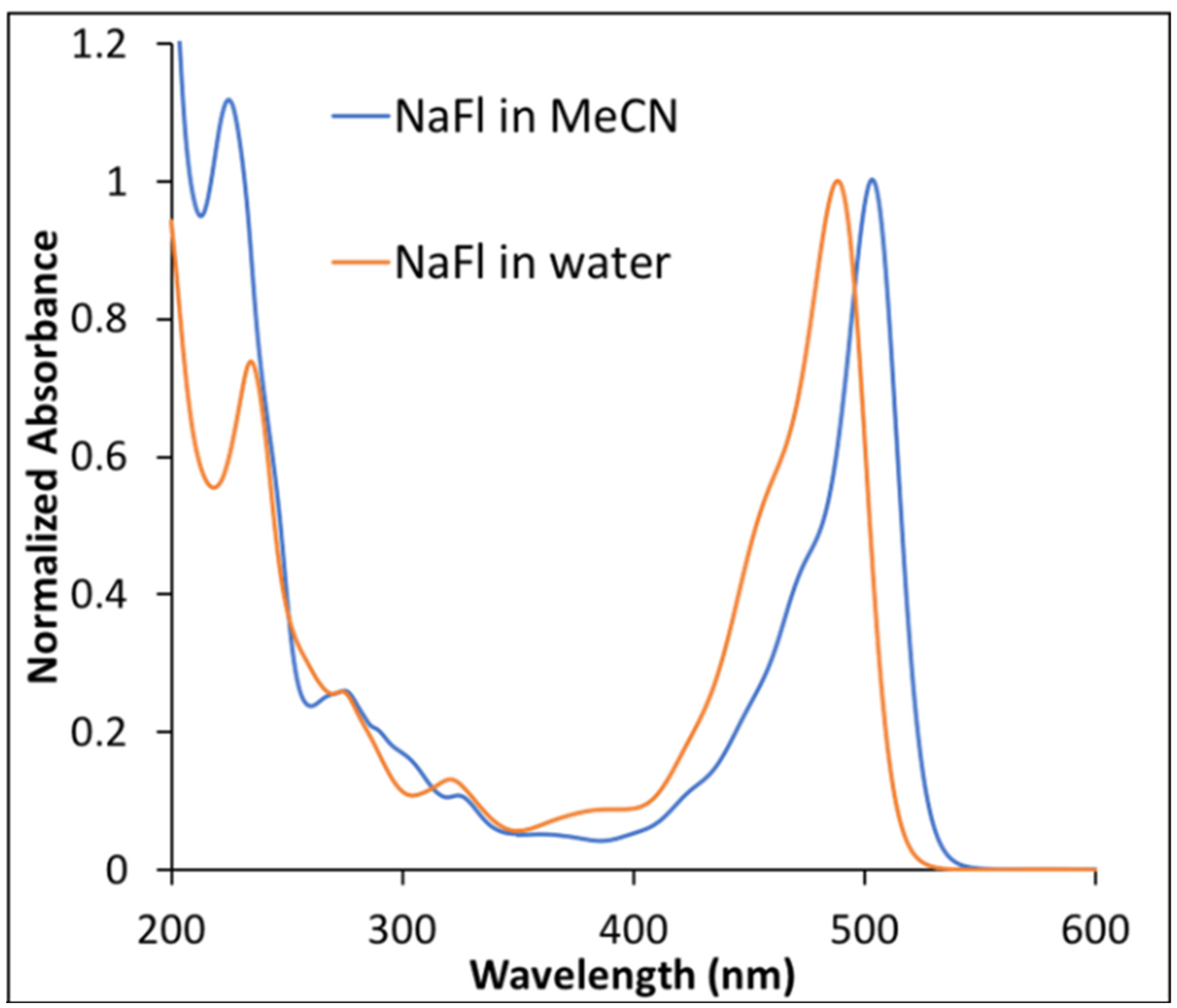
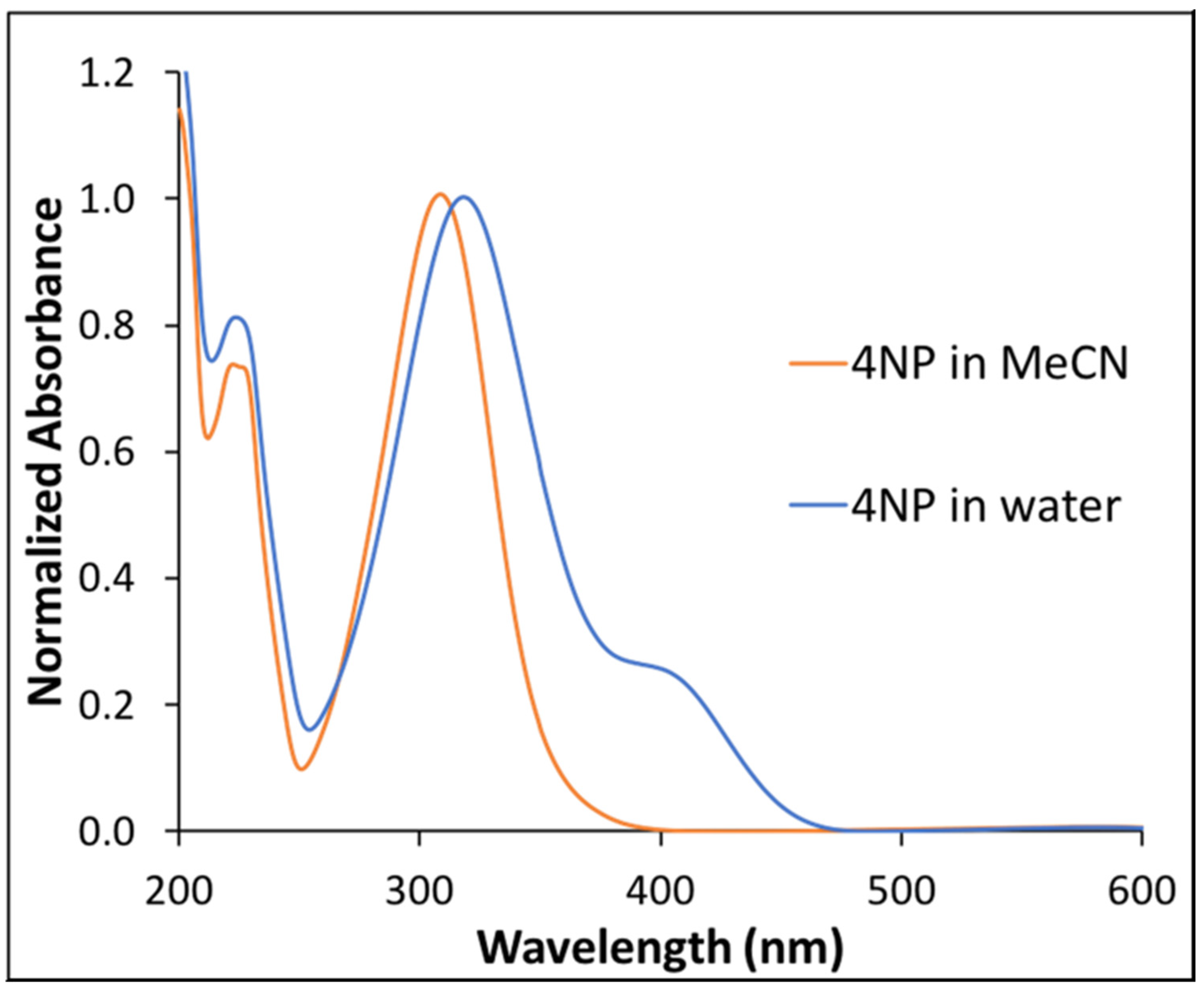

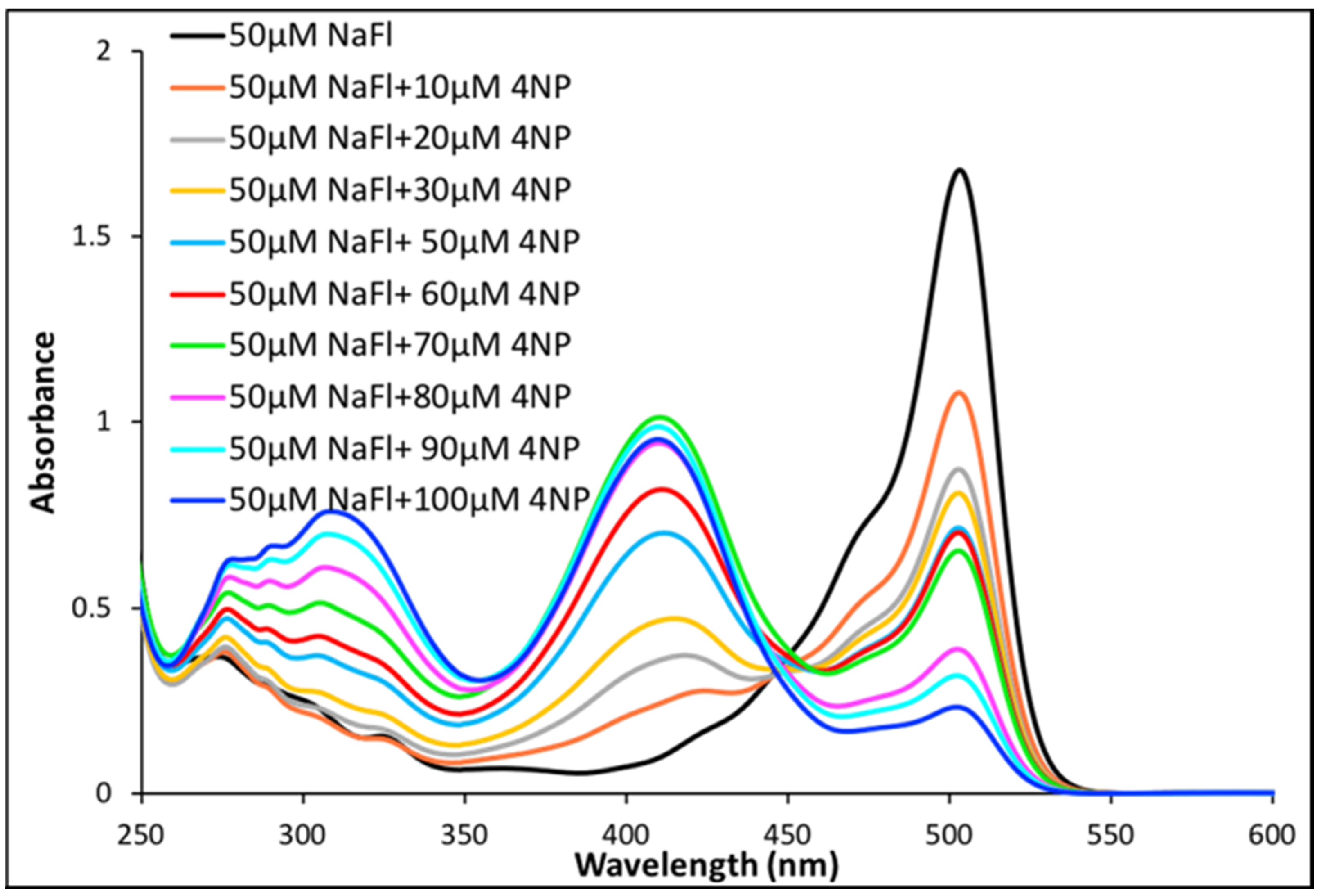

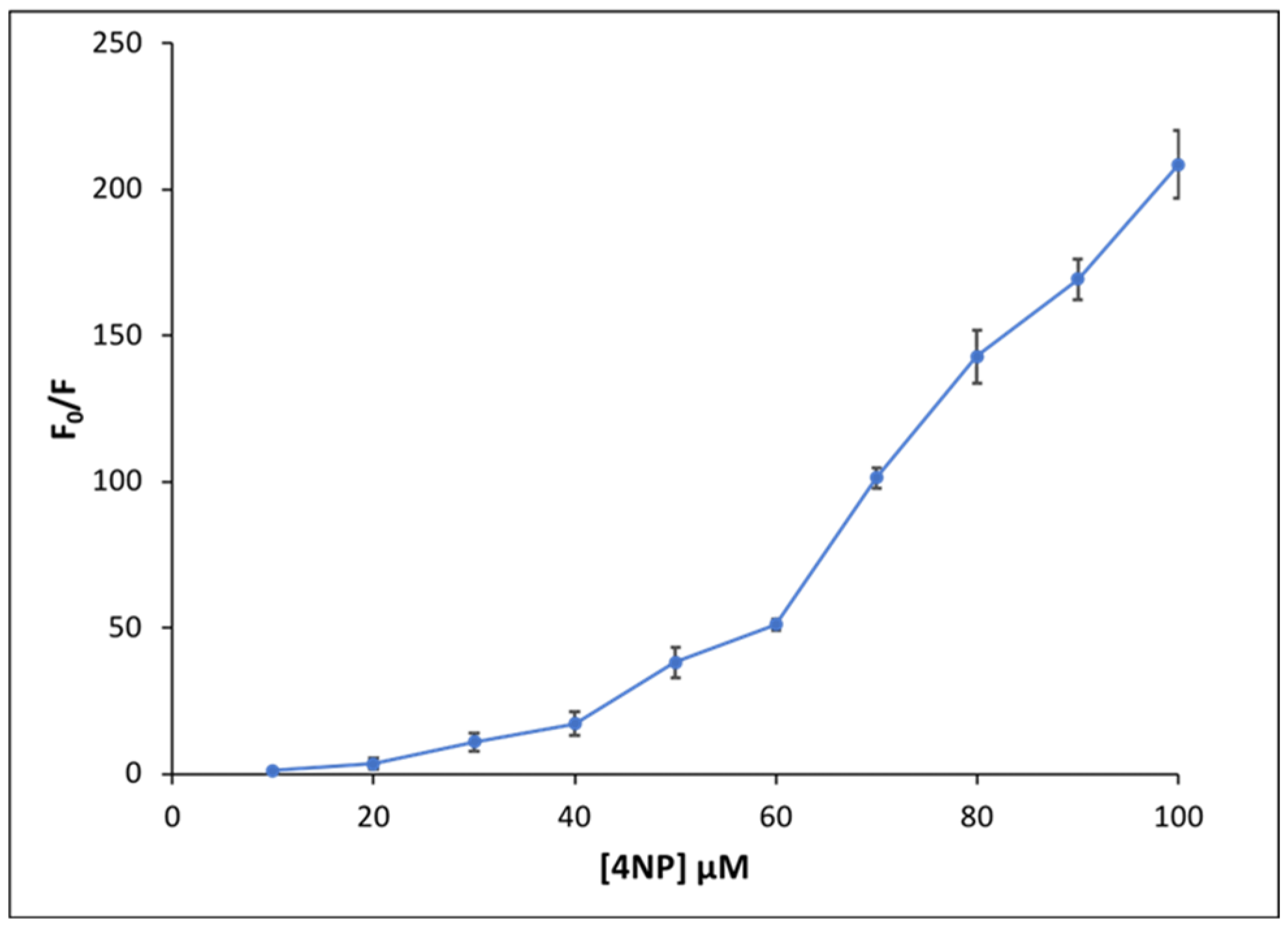

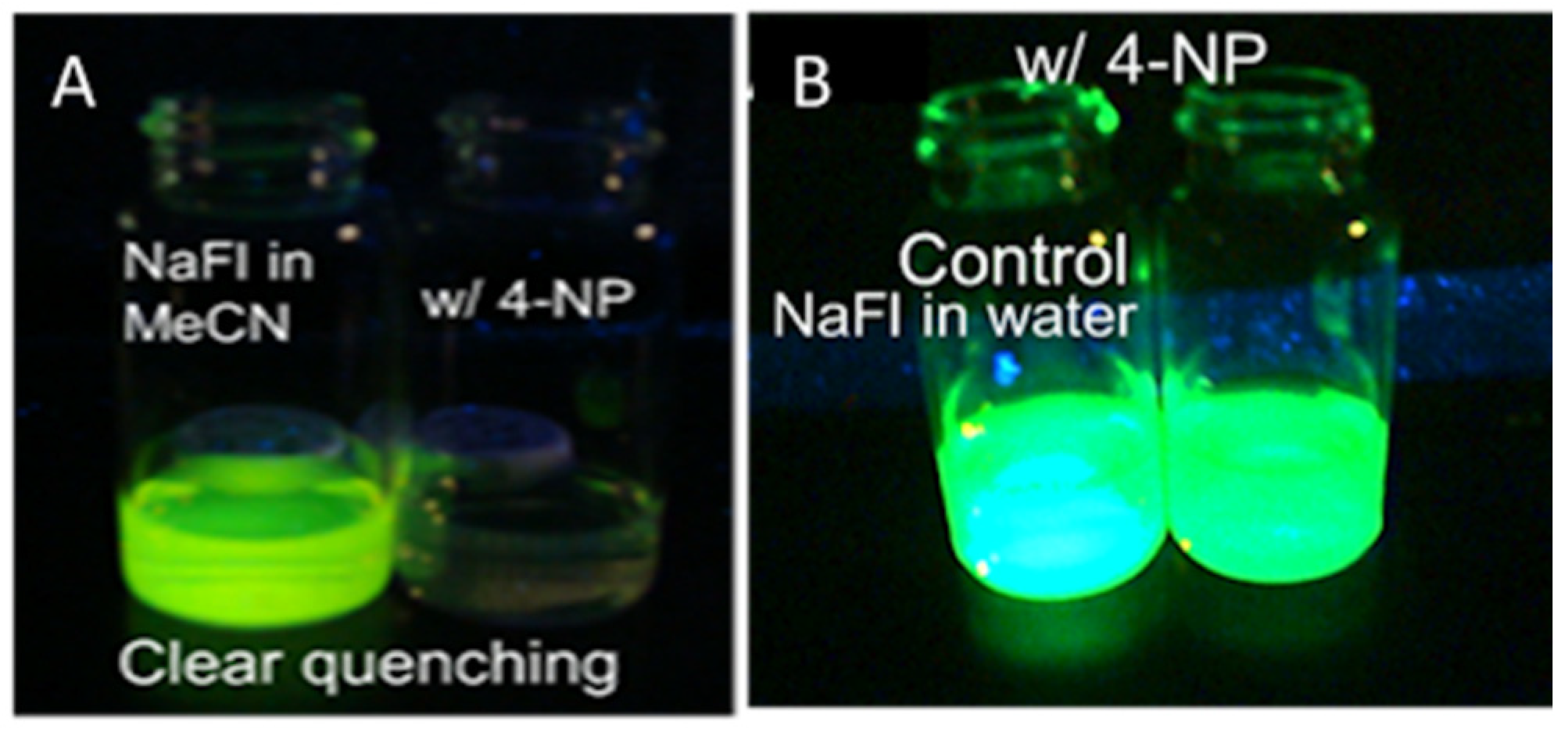
| Compounds | Solvent | Absorption Wavelength (nm) | Molar Absorptivity (M−1cm−1) | Fluorescence Emission Wavelength (nm) |
|---|---|---|---|---|
| NaFl | H2O/MeCN | 490/510 | 62,500/31,800 | 515/528 |
| 3-nitrophenol (3NP) | H2O/MeCN | 225, 290/220, 280 | 4600, 1500/6100, 2300 | ---- |
| 4-Nitrophenol (4NP) | H2O/MeCN | 230, 320, 405/225, 310 | 9300, 8100, 15,700/7200, 10,000 | ---- |
| 4-nitrotoluene (4NT) | H2O/MeCN | 285/275 | 8600/12,900 | ---- |
| 2,4-dinitrotoluene (2,4DNT) | H2O/MeCN | 250/245 | 6400/11,300 | ---- |
Publisher’s Note: MDPI stays neutral with regard to jurisdictional claims in published maps and institutional affiliations. |
© 2021 by the authors. Licensee MDPI, Basel, Switzerland. This article is an open access article distributed under the terms and conditions of the Creative Commons Attribution (CC BY) license (https://creativecommons.org/licenses/by/4.0/).
Share and Cite
Le, T.; Khan, Y.; Speller, N.; Bashiru, M.; Macchi, S.; Warner, I.; Siraj, N. A Highly Selective Economical Sensor for 4-Nitrophenol. Sustain. Chem. 2021, 2, 506-520. https://doi.org/10.3390/suschem2030028
Le T, Khan Y, Speller N, Bashiru M, Macchi S, Warner I, Siraj N. A Highly Selective Economical Sensor for 4-Nitrophenol. Sustainable Chemistry. 2021; 2(3):506-520. https://doi.org/10.3390/suschem2030028
Chicago/Turabian StyleLe, Thuy, Yusuf Khan, Nicholas Speller, Mujeebat Bashiru, Samantha Macchi, Isiah Warner, and Noureen Siraj. 2021. "A Highly Selective Economical Sensor for 4-Nitrophenol" Sustainable Chemistry 2, no. 3: 506-520. https://doi.org/10.3390/suschem2030028
APA StyleLe, T., Khan, Y., Speller, N., Bashiru, M., Macchi, S., Warner, I., & Siraj, N. (2021). A Highly Selective Economical Sensor for 4-Nitrophenol. Sustainable Chemistry, 2(3), 506-520. https://doi.org/10.3390/suschem2030028







